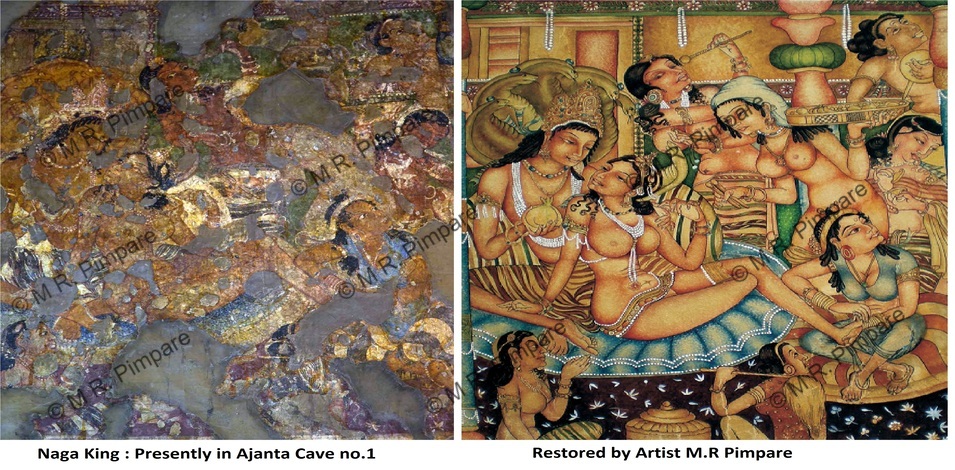Need fot Preservation
Ajanta may not be dying yet. But like Venice it is incurably sick. The unique cave paintings of Ajanta, for decades, have awed visitors from all over the world, are rapidly becoming a tragic monument to archaeological neglect. The condition of the famous Buddhist cave paintings has visibly deteriorated over the years and even though the caves - one of the world's oldest monasteries - have now been put on the world heritage list, the historic works of ancient Indian art are being starved of the expert attention they urgently require. The biggest threat to these ethereal cave paintings - which date over various centuries from the second century onwards - comes from gawking visitors. The 22 isolated caves, situated near the modern - day city of Aurangabad, were originally inhabited by the handful of Buddhist monks who created the paintings. But since 1819, when the caves were accidentally discovered by a British soldier from the Madras army, a flood of people has invaded their serenity.
Today, on an average, the caves are visited by between 3,000 and 5,000 people every day. Not surprisingly, therefore, carbonization caused by human breath has affected the paintings adversely.
Worse still, some carry umbrellas or sticks which often leave scratches on the exquisitely painted pillars. The caves are dark and the few attendants present are literally in the dark about what the visitors are doing. In fact, many of the attendants who ought to keep an eye on the paintings are busier playing guides to tourists for that extra buck. Lights pose yet another danger. Tourists can hire 40 watt bulbs for one and a half hours for certain caves, provided they do not spend more than 15 minutes in each cave and not too long before any one painting. But this rule is observed more in the breach: the lights are focused well beyond the allowed time on the more well-known works like the Black Princess and the apsaras with the famous swaying 'S' curve.
Ultra-violet rays are harmful to the paintings and make them fade, say restorers. Moreover, visitors bring in dust on their shoes and on their person - adding considerably to the dust already on the paintings. The denuded hill opposite the caves only aggravates the dust problem.
Besides the deterioration caused by age and the callous visitors, there are the more deliberate acts of man damaging the paintings. A few have been destroyed in restoration work. Others have been tampered with by over - zealous restorers. Says a former guide: "I have seen attendants put their own strokes, changing thereby the expressions, depth and perspective of the paintings in Cave 17. Attendants also clean paintings and in the process rub hard things against them."
Ajanta also has its own painter's devil: shellac, a varnish used by Italian expert L. Cecconi who was called to restore the paintings by the Nizam of Hyderabad when the caves were in his care. Over the years, the shellac, which was not uniformly applied, attracted carbon and other matter. It first became brittle and then translucent. Some of the paintings even became chalky. And when the Archaeological Survey of India (ASI) restorers tried to remove this varnish, hits of the paint came off with the varnish, leaving gaps in the paintings. The Buddhist monks did not paint directly on the walls and ceilings: they painted on a one-inch thick paste of rice, gum clay and mud which was applied on the cave surfaces. With gradual decay of the binding medium, chunks of paintings have fallen off.
The paintings have also suffered from a certain amount of bio-degradation, caused by microbes and spores settling on their surface. Smoke and beeswax have also altered their tonal value. Insects have added their bit: silver fish have eaten into some of the works. Bat excreta has created new designs on the paintings. Unfortunately, only two of the caves have been fumigated because there isn't enough money. All the caves need to be fumigated according to the experts.
Under such conditions, it is little wonder that the beauty of the paintings and its historic legacy is being gradually buried under layers of neglect and official apathy. And if the present situation is allowed to continue, it won't be long before the enigmatic smiles on the serene faces of the apsaras are wiped out forever.
AJANTA ELLORA TRUST
Address: Ellora Visiting Center, Opposite Ellora Caves Aurangabad, Maharashtra - 431102
Phone: +91 7276876884
What's App:+91 7276876884
Email: ajantaelloratrust@gmail.com



